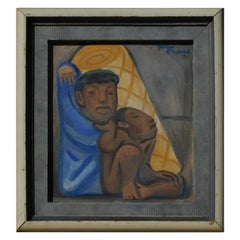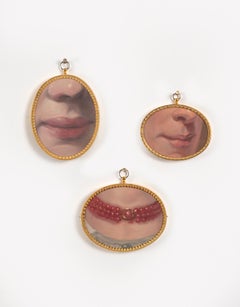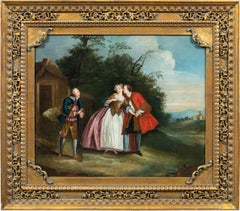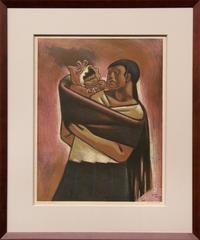Jean Charlot Figurative Paintings
to
1
Overall Width
to
Overall Height
to
1
1
1
1
1
1
1
1
5
462
330
261
214
1
Artist: Jean Charlot
Jean Charlot Original Mexican Mural Style Painting, Fresco on Board, 1934
By Jean Charlot
Located in Phoenix, AZ
Jean Charlot Fresco style painting in plaster on board in the original artist made frame.
Titled on a label on the verso: "Bed Time.” In excellent condition.
Signed by the artist upp...
Category
1930s Jean Charlot Figurative Paintings
Materials
Paint
Related Items
They after Batoni and Hodges
By Derrick Guild
Located in London, GB
Dimensions variable: medium oval 7.5cm x 9.5cm; large oval 9cm x 11cm.
Derrick Guild is a Scottish artist whose paintings fragment Old Master works to explore the social fabric bene...
Category
2010s Contemporary Jean Charlot Figurative Paintings
Materials
Linen, Oil
Rococò French painter - 18th century figure painting - Gallant scene Lancret
Located in Varmo, IT
French Rococo painter (18th century) - Gallant scene in a landscape.
63.5 x 76 cm without frame, 91 x 102.5 cm with frame.
Antique oil painting on canvas, in a carved and gilded wo...
Category
Mid-18th Century Rococo Jean Charlot Figurative Paintings
Materials
Canvas, Oil
$2,364 Sale Price
50% Off
H 35.83 in W 40.36 in
Modernist scene in Paris oil on canvas painting urbanscape
By Luis Sagasta
Located in Barcelona, Barcelona
Frameless.
Luis Sagasta, an Impressionist Spanish painter, chose as his subjects scenes of the wealthy, such as racecourses and richly-dressed ladies and gentlemen in park settings....
Category
1990s Post-Modern Jean Charlot Figurative Paintings
Materials
Oil, Canvas
$605 Sale Price
43% Off
H 18.12 in W 21.66 in
Ribera workshop (Baroque master) - 17th century figure painting - Saint Joseph
By Jusepe de Ribera
Located in Varmo, IT
Jusepe de Ribera (Xàtiva 1591 - Naples 1652) circle of - San Giuseppe.
108 x 80 cm without frame, 123 x 95 cm with frame.
Antique oil painting on canvas, in a carved and gilded woo...
Category
Mid-17th Century Baroque Jean Charlot Figurative Paintings
Materials
Canvas, Oil
$7,175 Sale Price
25% Off
H 48.43 in W 37.41 in
Vintage Montmartre Paris Impressionist Oil Landscape 1950's
Located in Douglas Manor, NY
6011 Oil on canvas the streets of Paris set in a vintage wood frame
Image size 9.5x8"
Category
1950s Jean Charlot Figurative Paintings
Materials
Oil
Antonio Diziani (Venetian master) - 18th century landscape painting Countryside
By Antonio Diziani
Located in Varmo, IT
Antonio Diziani (Venice 1737 - Venice 1797) - Bucolic landscape with characters and wagon.
45 x 101.5 cm without frame, 55.5 x 111.5 cm with frame.
Ancient oil painting on canvas, ...
Category
Late 18th Century Rococo Jean Charlot Figurative Paintings
Materials
Canvas, Oil
$7,175 Sale Price
33% Off
H 21.86 in W 43.9 in
Antique Oil Painting Two French Maidens
Located in Douglas Manor, NY
5071 Antique French oil painting set in a ornate gilt frame
Image size 10x7.5"
Category
1890s Jean Charlot Figurative Paintings
Materials
Oil
plowing with oxen oil on board painting Spain
By Juan Soler
Located in Barcelona, Barcelona
Oil measures 30x30 cm.
Frame measures 52x52 cm.
He was born in 1951. Under the direction of the teacher Pedro Bermejo, he began his artistic career, quickly standing out and observing in his works an unusual mastery of drawing.
A highly mature painter who has known how to stop time in all his works. His themes are preferably costumbrist, although in his work it is usual to see 18th century themes, with horse carriages, hats, umbrellas and still lifes.
Observing his work reminds us, due to the theme, of Maestro Palmero...
Category
21st Century and Contemporary Post-Impressionist Jean Charlot Figurative Paintings
Materials
Board, Oil
$411 Sale Price
42% Off
H 11.82 in W 11.82 in
Spanish fishermen on the beach Spain oil on board painting
By Gabriel Casarrubios
Located in Barcelona, Barcelona
Gabriel Casarrubios Martín (1953) - Fishermen - Oil on panel
Oil size 27x22 cm.
Frameless.
Gabriel Casarrubios Martín (1953)
The Toledo artist trained in Fine Arts in Madrid, at th...
Category
21st Century and Contemporary Post-Impressionist Jean Charlot Figurative Paintings
Materials
Board, Oil
$306 Sale Price
57% Off
H 10.63 in W 8.67 in
Enlightenment Italian painter - 18th century figure painting - Portrait - Italy
Located in Varmo, IT
Italian painter (18th century) - Portrait of a gentleman with aphorism.
92 x 68 cm.
Antique oil painting on canvas, without frame (not signed).
- Inscription: "There are more madm...
Category
Mid-18th Century Rococo Jean Charlot Figurative Paintings
Materials
Canvas, Oil
$1,773 Sale Price
25% Off
H 36.23 in W 26.78 in
"Brunch By Chloe NYC Bleecker St" Impressionistic Scene Oil Painting on Canvas
By Cindy Shaoul
Located in New York, NY
"With shades of Pierre Bonnard’s Parisian street vistas and Edward Hopper’s New York shopfronts, American impressionist Cindy Shaoul’s oil paintings depict the much-loved locales and...
Category
2010s American Impressionist Jean Charlot Figurative Paintings
Materials
Oil, Canvas
$4,200
H 36 in W 48 in D 1.5 in
surreal woman face oil on canvas painting
By Miquel Torner de Semir
Located in Barcelona, Barcelona
Miquel Torner de Semir (1938) - Surrealist figure - Oil on canvas
Oil measures 46x38 cm.
Frameless.
Miquel Torner de Semir (1938)
Catalan painter attracted by the Middle Ages and I...
Category
1990s Surrealist Jean Charlot Figurative Paintings
Materials
Canvas, Oil
$631 Sale Price
56% Off
H 18.12 in W 14.97 in
Previously Available Items
Mexican Mother and Child
By Jean Charlot
Located in Denver, CO
Alternate titled: Pilgrims
Color lithograph (one state)
Printed in Colorado Springs, Colorado with Lawrence Barrett.
Morse #520
Housed in a custom frame with all archival materia...
Category
1940s American Modern Jean Charlot Figurative Paintings
Materials
Lithograph
Jean Charlot figurative paintings for sale on 1stDibs.
Find a wide variety of authentic Jean Charlot figurative paintings available for sale on 1stDibs. You can also browse by medium to find art by Jean Charlot in paint and more. Not every interior allows for large Jean Charlot figurative paintings, so small editions measuring 15 inches across are available. Customers who are interested in this artist might also find the work of Paul Emile Pissarro, Alexandre Louis Jacob, and Marcel Dyf. Jean Charlot figurative paintings prices can differ depending upon medium, time period and other attributes. On 1stDibs, the price for these items starts at $15,500 and tops out at $15,500, while the average work can sell for $15,500.



